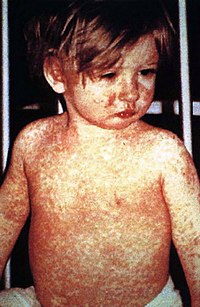
Gefitinib-Induced Cutaneous Toxicities in Brown Norway Rats Are Associated with Macrophage Infiltration.
Sign Up to like & getrecommendations! Published in 2020 at "Inflammation"
DOI: 10.1007/s10753-020-01281-2
Abstract: Gefitinib (Iressa), is a selective epidermal growth factor receptor (EGFR) tyrosine kinase inhibitor (TKI), used in the targeted treatment of locally advanced or metastatic non-small cell lung cancer (NSCLC). Skin toxicity is the major adverse… read more here.
Keywords: gefitinib induced; gefitinib; macrophage infiltration; cutaneous toxicities ... See more keywords

Cutaneous toxicities of new treatments for melanoma
Sign Up to like & getrecommendations! Published in 2018 at "Clinical and Translational Oncology"
DOI: 10.1007/s12094-018-1891-7
Abstract: New drugs against advanced melanoma have emerged during last decade. Target therapy and immunotherapy have changed the management of patients with metastatic disease. Along with its generalized use, drug toxicities have appeared and the skin… read more here.
Keywords: toxicities new; cutaneous toxicities; treatments melanoma; therapy ... See more keywords

Preventive effect of Diallyl Trisulfide on cutaneous toxicities induced by EGFR inhibitor
Sign Up to like & getrecommendations! Published in 2019 at "International Immunopharmacology"
DOI: 10.1016/j.intimp.2019.01.023
Abstract: &NA; Cutaneous toxicities are the commonest side effects in patients with cancer treated using epidermal growth factor receptor inhibitors such as erlotinib. For patients with such toxicities, there is a lack of safe, effective pharmacological… read more here.
Keywords: diallyl trisulfide; group; skin; effect diallyl ... See more keywords

Adverse cutaneous toxicities by PD-1/PD-L1 immune checkpoint inhibitors: Pathogenesis, Treatment, and Surveillance.
Sign Up to like & getrecommendations! Published in 2022 at "Cutaneous and ocular toxicology"
DOI: 10.1080/15569527.2022.2034842
Abstract: Introduction-The therapeutic use of humanized monoclonal programmed cell death 1 (PD-1) (pembrolizumab, and nivolumab) and programmed cell death ligand-1 (PD-L1) (atezolizumab, avelumab, durvalumab) immune checkpoint inhibitors (ICPi) as potent anticancer therapies is rapidly increasing. The… read more here.
Keywords: immune checkpoint; adverse events; cutaneous toxicities; checkpoint ... See more keywords

Cutaneous adverse events of anti-programmed death 1 antibodies combined with anti-cytotoxic T-lymphocyte-associated protein 4 therapy use in patients with metastatic melanoma
Sign Up to like & getrecommendations! Published in 2019 at "Melanoma Research"
DOI: 10.1097/cmr.0000000000000518
Abstract: To date, cutaneous toxicities of combination therapies of anti-programmed death-1 (anti-PD1) and ipilimumab are poorly described. Understanding cutaneous presentations will aid clinicians with early diagnoses and treatments. We aim to describe and compare the cutaneous… read more here.
Keywords: combination; metastatic melanoma; patients metastatic; cutaneous toxicities ... See more keywords

Follicular T helper cells and cutaneous T‐cell lymphomas
Sign Up to like & getrecommendations! Published in 2022 at "British Journal of Dermatology"
DOI: 10.1111/bjd.21839
Abstract: centre retrospective international cohort study designed to investigate clinical associations of skin toxicities induced by different ICI therapies. The study revealed that ICI-induced cutaneous toxicities may depend on certain factors, such as the specific agent… read more here.
Keywords: cell; follicular helper; cutaneous toxicities; skin toxicities ... See more keywords

Zinc deficiency associated with cutaneous toxicities induced by epidermal growth factor receptor tyrosine kinase inhibitor therapy in patients with lung adenocarcinoma
Sign Up to like & getrecommendations! Published in 2022 at "Journal of the European Academy of Dermatology and Venereology"
DOI: 10.1111/jdv.18703
Abstract: Cutaneous toxicities are common adverse effects following epidermal growth factor receptor tyrosine kinase inhibitor (EGFR‐TKI) therapy. Zinc deficiency causes diverse diseases, including skin toxicities. Therefore, this study aimed to investigate the role of zinc deficiency… read more here.
Keywords: zinc deficiency; zinc; cutaneous toxicities; epidermal growth ... See more keywords

Comparison of Th17 cells mediated immunological response among asthmatic children with or without allergic rhinitis.
Sign Up to like & getrecommendations! Published in 2019 at "Asian Pacific Journal of Allergy and Immunology"
DOI: 10.12932/ap-140317-0047
Abstract: BACKGROUND Several prospective studies have been conducted in epidermal growth factor receptor (EGFR) inhibitor-related cutaneous reactions in Caucasian patients, but prospective studies in Asian populations are scarce. OBJECTIVE To investigate the cutaneous side effects of… read more here.
Keywords: response; cutaneous reactions; cancer; cancer patients ... See more keywords

Cutaneous Toxicity Associated With Enfortumab Vedotin: A Real-Word Study Leveraging U.S. Food and Drug Administration Adverse Event Reporting System
Sign Up to like & getrecommendations! Published in 2022 at "Frontiers in Oncology"
DOI: 10.3389/fonc.2021.801199
Abstract: Introduction Enfortumab vedotin (EV) has been demonstrated to have a significant response rate in early phase trials and is known for its tolerable side-effect profile. Emerging case reports have raised awareness of cutaneous toxicities, which… read more here.
Keywords: ror; enfortumab vedotin; cutaneous toxicities; food drug ... See more keywords